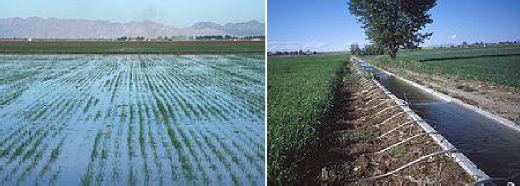2.3. Based on Technique of Distribution of Water
Various types of irrigation techniques differ in how the water obtained from the source is distributed within the field. In general, the goal is to supply the entire field uniformly with water, so that each plant has the amount of water it needs, neither too much nor too little. The various irrigation techniques are as under:
♤ Surface Irrigation: In surface irrigation systems, water moves over and across the land by simple gravity flow in order to wet it and to infiltrate into the soil. It is often called flood irrigation when the irrigation results in flooding or near flooding of the cultivated land. Surface irrigation can be subdivided into:
o Basin irrigation has historically been used in small areas having level surfaces that are surrounded by earth banks (figure 3). The water is applied rapidly to the entire basin and is allowed to infiltrate. Basins may be linked sequentially so that drainage from one basin is diverted into the next once the desired soil water deficit is satisfied.
o Furrow irrigation is conducted by creating small parallel channels along the field length in the direction of predominant slope (figure 4). Water is applied to the top end of each furrow and flows down the field under the influence of gravity.
o Border strip, otherwise known as border check or bay irrigation could be considered as a hybrid of level basin and furrow irrigation. The field is divided into a number of bays or strips; each bay is separated by raised earth check banks (borders). The bays are typically longer and narrower compared to basin irrigation and are orientated to align lengthwise with the slope of the field.

